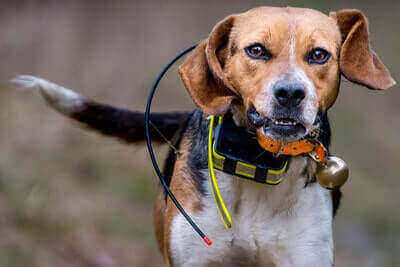Disclosure: We may earn commissions if you purchase products after clicking on a link from our site.
Would you like to know how to train a dog to track deer? Do you need to train your little friend? A trained dog can be a great hunting partner out in the woods. In this article, we discuss how to train a dog to track deer. After reading this article, you will have the information you need to turn your little furry friend into a good deer tracker.
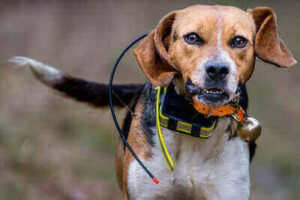
How To Train A Dog To Track Deer
1. Early Training
Begin training your puppy how to track a deer early if that is possible. If your dog is a puppy, you can start early training at seven weeks. Starting training this early will establish the groundwork for a bonafide tracking dog in the future. This early training is more psychological than anything else. You can learn how to pattern deer in early season from this article.
2. Play Games To Bond
You can play a variety of games with your puppy to develop that bond with him. You can start by throwing objects at a distance and letting him retrieve them and bring them back to you. Praise him for retrieving and returning it. From objects you can then use deer liver for fun drags for about 20 feet. Let him go after it and get the satisfaction of tracking and getting the liver.
3. Line Of Deer Blood
You can move on from liver drags to a dripped line of deer blood. You can reward your puppy at the end of the line of blood with something like the deer tail or hide. This reward will heighten his prey instinct and condition him to remain on the trail of a deer until it is found. This is slow but intentional conditioning.
Don’t use fresh deer hide to create the drags. Fresh deer hide leaves too much scent and this may make the puppy loose and sloppy while following the trail. Instead, use a two-inch square sponge or a squeeze bottle to create the trail with deer blood. You can learn how to tan a deer hide from this article.

4. Amuse & Challenge
At all stages of the training, you should make it amusing and challenging for your puppy. A deer’s tail or hide at the end of a blood trail will just be what he will want. Something to show for his time and effort tracking the blood for that distance. Something that he can sink his teeth into and have fun with.
5. Sharp Turns
Create winding and sharp turns of the bloodline to make following it more challenging for your puppy as he grows and develops his tracking ability. Real deer blood trails will meander into different routes with turns, stops, and other movements. You want to train your puppy to be ready for complicated and sharp turns.
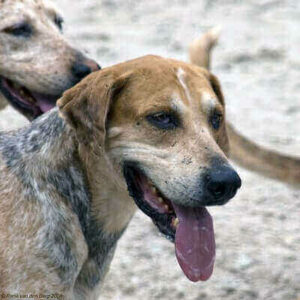
6. Age The Blood Line
As your puppy grows older and more experienced with your deer tracking training, you want to progress from fresh bloodlines to older bloodlines. Let the blood line be older than a fresh line for about two to four hours or even more. The puppy’s nose will mature quicker than his brain and this will help him pick up the scent from older blood lines and track them.
Blood lines give off scent particles for days. Blood lines age slower than a man’s track or that of a raccoon. It is possible that a puppy can easily track blood lines that are up to 10 hours old.
7. Walking By You
As the training continues, you should be teaching your puppy to learn to walk calmly by your side on a short leash. A light tracking leash of 20 feet will do the job. The plastic clothes line is usable if the puppy is under 15 pounds. The plastic clothes line creates very little friction and it is very light. You can easily steer him in whichever direction you want him to go and keep him focused. For puppies that weigh more than 15 pounds, a cotton or polypropylene clothes line will work well.

8. Tracking Leash
Using a tracking leash is an essential step in training a dog to track deer effectively. The leash provides control and guidance to the dog, ensuring that it stays focused on the task at hand without getting distracted by other scents or trails.
During training sessions, the tracking leash allows the handler to maintain close proximity to the dog, offering encouragement, commands, and corrections as needed. It also helps prevent the dog from running off or chasing other animals, keeping it on track and reinforcing the desired behavior of following the deer scent.
Additionally, the leash enables the handler to monitor the dog’s progress, observe its tracking skills, and intervene if necessary to address any issues or obstacles encountered during the tracking process. Overall, using a tracking leash facilitates a structured and controlled training environment, laying the foundation for the dog to develop reliable tracking abilities essential for deer hunting and recovery tasks.
9. Change The Training Area
It is easy to want to continue laying training lines in the same areas. Dogs and puppies have good memories of where they located items in the past. With their mature noses, they are informed of where earlier blood lines are located. For puppies that are 12 weeks old and have been working lines that are more than a hundred yards long, change the location of the training area to a different field.
10. Natural Desire Channeling
Training for tracking deer should be approached as channeling the natural desire for the puppy with the right instinct. It should not be seen as obedience training. The aim is to develop his ability to solve tracking problems. Allow his natural desire and curiosity to drive him in the deer tracking training.
11. Avoid Repeated Training
Always try to make the tracking training fun and challenging. Don’t repeat the same training exercises too often. Some puppies will become bored with the same exercises. Make it spontaneous depending on his mood and the weather. A session every three days is a good schedule. As your puppy progresses with the training into more challenging lines, a 500-yard line once a week may be good.

Deer Tracking Dogs
1. Jagdterrier
The Jagdterrier, known for its tenacity, intelligence, and strong hunting instincts, is a breed renowned for its proficiency in deer tracking. Originating from Germany, this versatile working dog was initially bred for hunting small game, including wild boar and foxes, but has also proven to be highly adept at tracking wounded deer.
With a keen sense of smell and a relentless drive to pursue its quarry, the Jagdterrier excels in following deer trails over varied terrain, including dense forests and rugged landscapes. Its compact size and agile build enable it to navigate through challenging environments with ease, while its determined nature ensures that it remains focused on the task at hand.
Renowned for its loyalty and trainability, the Jagdterrier forms a close bond with its handler, making it an invaluable asset in deer tracking and recovery operations. Whether working in the field or assisting hunters in locating wounded game, the Jagdterrier’s exceptional tracking abilities make it a highly prized companion for those seeking to maximize their success in deer hunting endeavors.
2. Blue Lacy
The Blue Lacy, a breed originating from Texas, is highly regarded for its exceptional tracking abilities, making it a valuable asset in deer tracking endeavors. Bred for hunting and herding tasks, this intelligent and versatile breed possesses a keen sense of smell and an innate instinct for tracking game, including deer.
With its agile and athletic build, the Blue Lacy is well-suited for navigating various terrains, from dense forests to open fields, in pursuit of wounded or elusive deer. Known for its loyalty, determination, and strong work ethic, the Blue Lacy forms a close bond with its handler and eagerly tackles the task of tracking deer with unwavering focus and enthusiasm.
Whether employed by hunters for tracking wounded game or assisting in search and rescue operations, the Blue Lacy’s natural tracking ability and unwavering dedication make it an invaluable companion in the pursuit of deer and other game species.
3. Bavarian Mountain Bloodhound
The Bavarian Mountain Bloodhound, also known as the Bavarian Mountain Scent Hound, is a breed renowned for its exceptional tracking prowess, particularly in deer tracking. Originating from the Bavarian region of Germany, this breed was developed specifically for hunting large game, including deer, in challenging mountainous terrain.
With its keen sense of smell and unwavering determination, the Bavarian Mountain Bloodhound excels in tracking wounded or elusive deer over vast distances and diverse landscapes. Possessing a strong, muscular build and a tireless work ethic, these dogs are well-equipped to navigate rugged terrain and harsh weather conditions in pursuit of their quarry.
Known for their calm demeanor, intelligence, and strong hunting instincts, Bavarian Mountain Bloodhounds form a close bond with their handlers and demonstrate remarkable focus and tenacity when on the trail of deer. Whether used for hunting purposes or in search and rescue operations, the Bavarian Mountain Bloodhound’s exceptional tracking abilities make it a highly valued asset in the pursuit of deer and other game species.
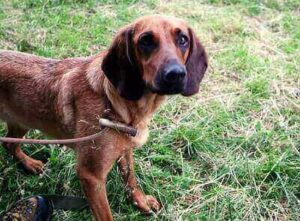
4. Wachtelhund
The Wachtelhund, also known as the German Spaniel, is a versatile hunting dog breed that excels in various tasks, including tracking wounded game such as deer. Originating from Germany, the Wachtelhund was developed specifically for hunting small game and retrieving waterfowl, but its exceptional scenting abilities and strong tracking instincts also make it well-suited for deer tracking.
With its medium-sized, sturdy build and keen sense of smell, the Wachtelhund is adept at following the scent trail of wounded or elusive deer through various terrains, including dense forests and rugged terrain. Known for their intelligence, trainability, and strong work ethic, Wachtelhunds form strong bonds with their handlers and demonstrate unwavering determination when on the trail.
Their ability to track and locate wounded deer efficiently makes them valuable assets in hunting scenarios, aiding hunters in recovering game ethically and effectively. Additionally, their friendly and sociable nature makes them cherished companions and loyal hunting partners for those seeking a versatile and reliable tracking dog.
5. Deutsch Drahthaar
The Deutsch Drahthaar, or German Wirehaired Pointer, is a versatile hunting breed renowned for its exceptional tracking abilities and versatility in the field. Originating from Germany, the Deutsch Drahthaar was selectively bred for its ruggedness, intelligence, and keen sense of smell, making it an excellent choice for tracking wounded or elusive deer.
With its wiry coat, sturdy build, and boundless energy, the Deutsch Drahthaar is well-equipped to navigate various terrains and weather conditions while on the hunt. These dogs possess a strong prey drive and an innate instinct to follow scent trails diligently, making them valuable assets in deer tracking scenarios.
Known for their loyalty, trainability, and determination, Deutsch Drahthaars forge strong bonds with their handlers and excel in working closely with them to locate and recover wounded game. Their versatility extends beyond tracking, as they are also skilled in other hunting tasks such as pointing, flushing, and retrieving, making them cherished companions and indispensable hunting partners for those seeking a reliable and multi-talented tracking dog. You can improve your duck hunting from this article on the best duck hunting tips.

6. Dachshund
While Dachshunds are beloved for their distinctive appearance and spirited personality, they are not typically used as dedicated deer-tracking dogs. Originating from Germany, these small hounds were originally bred for hunting smaller game such as badgers, rabbits, and foxes, utilizing their keen sense of smell and compact size to navigate underground burrows and dens.
While they possess a strong hunting instinct and are capable of tracking scents, their small stature and short legs may limit their effectiveness in tracking larger game like deer over long distances or challenging terrain.
However, some Dachshunds may still exhibit tracking abilities and could potentially be trained for deer tracking in specific scenarios or as part of a larger tracking team. Nonetheless, their primary role remains as cherished companions and skilled hunters of smaller game.
7. Beagle
Beagles are renowned for their exceptional tracking abilities, but they are typically not used as deer-tracking dogs due to their smaller size and specialization in hunting smaller game, particularly rabbits. Originating from England, Beagles are scent hounds known for their keen sense of smell, relentless determination, and energetic nature.
While they excel in tracking scents over various terrains, their compact build and relatively short legs may limit their effectiveness in tracking larger game like deer, especially in dense forests or over long distances. However, some Beagles may demonstrate aptitude in tracking deer scent and could potentially be trained for deer tracking in specific situations or as part of a larger tracking team. Nonetheless, their primary role remains as beloved companions and skilled hunters of smaller game.
8. Slovakian Hound
The Slovakian Hound, also known as the Slovakian Rough-Haired Pointer, is a versatile and intelligent breed renowned for its exceptional tracking abilities, including tracking deer. Originating from Slovakia, this breed was developed for hunting various game in dense forests and rugged terrains.
With a keen sense of smell and a strong hunting instinct, Slovakian Hounds are highly adept at following scent trails over long distances. Their medium-sized build, sturdy frame, and endurance make them well-suited for tracking deer through challenging terrain.
Additionally, their rough coat protects against harsh weather conditions, allowing them to perform effectively in diverse environments. Known for their loyalty, courage, and trainability, Slovakian Hounds make excellent deer-tracking companions for hunters seeking a reliable and versatile tracking dog.
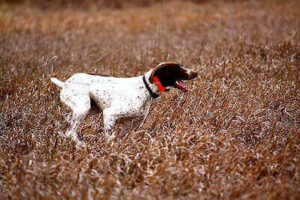
The Bottom Line
How to training a dog to track deer is not the hardest thing when hunting. It involves a series of steps that you have to carry out with your dog on a regular basis. You have to learn to cultivate their curiosity rather than obedience.
How to train your hunting dog is an exciting and rewarding experience for you and your dog. In this article, we discuss how to train a dog to track deer. It is our hope that it will help you train your dog as a great deer tracker. If you want to get dog training collars, then read this review on the best dog training collars.
